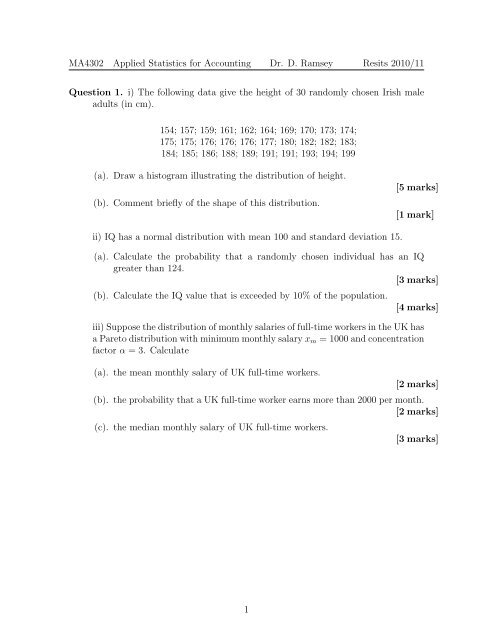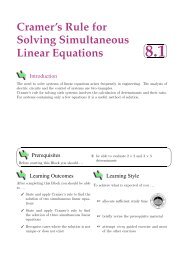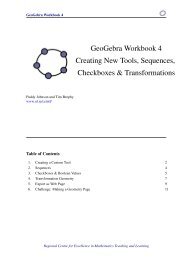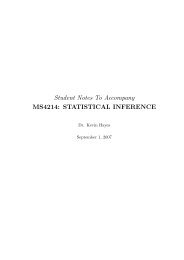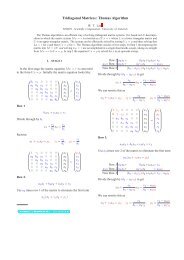MA4302 Applied Statistics for Accounting Dr. D. Ramsey Resits ...
MA4302 Applied Statistics for Accounting Dr. D. Ramsey Resits ...
MA4302 Applied Statistics for Accounting Dr. D. Ramsey Resits ...
Create successful ePaper yourself
Turn your PDF publications into a flip-book with our unique Google optimized e-Paper software.
<strong>MA4302</strong> <strong>Applied</strong> <strong>Statistics</strong> <strong>for</strong> <strong>Accounting</strong> <strong>Dr</strong>. D. <strong>Ramsey</strong> <strong>Resits</strong> 2010/11<br />
Question 1. i) The following data give the height of 30 randomly chosen Irish male<br />
adults (in cm).<br />
154; 157; 159; 161; 162; 164; 169; 170; 173; 174;<br />
175; 175; 176; 176; 176; 177; 180; 182; 182; 183;<br />
184; 185; 186; 188; 189; 191; 191; 193; 194; 199<br />
(a). <strong>Dr</strong>aw a histogram illustrating the distribution of height.<br />
(b). Comment briefly of the shape of this distribution.<br />
ii) IQ has a normal distribution with mean 100 and standard deviation 15.<br />
[5 marks]<br />
[1 mark]<br />
(a). Calculate the probability that a randomly chosen individual has an IQ<br />
greater than 124.<br />
[3 marks]<br />
(b). Calculate the IQ value that is exceeded by 10% of the population.<br />
[4 marks]<br />
iii) Suppose the distribution of monthly salaries of full-time workers in the UK has<br />
a Pareto distribution with minimum monthly salary xm = 1000 and concentration<br />
factor α = 3. Calculate<br />
(a). the mean monthly salary of UK full-time workers.<br />
[2 marks]<br />
(b). the probability that a UK full-time worker earns more than 2000 per month.<br />
[2 marks]<br />
(c). the median monthly salary of UK full-time workers.<br />
1<br />
[3 marks]
<strong>MA4302</strong> <strong>Applied</strong> <strong>Statistics</strong> <strong>for</strong> <strong>Accounting</strong> <strong>Dr</strong>. D. <strong>Ramsey</strong> <strong>Resits</strong> 2010/11<br />
Question 2. i) The discrete random variable X has the following distribution:<br />
x 0 1 2 3<br />
P (X = x) 0.1 0.3 0.4 k<br />
(a). Calculate the value of the constant k.<br />
(b). Calculate the expected value of the random variable X, E(X).<br />
[2 marks]<br />
[2 marks]<br />
(c). Suppose S is the sum of 100 numbers chosen independently from this distribution,<br />
calculate E(S).<br />
[2 marks]<br />
ii) A certain bank classifies the recipients of its mortgage loans as being low,<br />
medium or high risk. Past history has shown that 3% of low risk, 10% of medium<br />
risk and 30% of high risk borrowers default on their loans. 60% of borrowers are<br />
classified as low risk, 30% are classified as medium risk and 10% are classified as<br />
high risk.<br />
(a). Calculate the probability that a randomly chosen borrower defaults on<br />
his/her loan.<br />
[4 marks]<br />
(b). Suppose that an individual defaults on their loan. Calculate the probability<br />
that such an individual was classified as being high risk.<br />
[3 marks]<br />
iii) A die is thrown 10 times. Let X be the number of sixes obtained.<br />
(a). What is the distribution of X (give its name and the values of the relevant<br />
parameters)?<br />
[1 mark]<br />
(b). Calculate the probability that no sixes are obtained i.e. P (X = 0).<br />
(c). Calculate the probability that at least two sixes are obtained.<br />
2<br />
[2 marks]<br />
[4 marks]
<strong>MA4302</strong> <strong>Applied</strong> <strong>Statistics</strong> <strong>for</strong> <strong>Accounting</strong> <strong>Dr</strong>. D. <strong>Ramsey</strong> <strong>Resits</strong> 2010/11<br />
Question 3. i) A sample of 64 Irish full-time workers was taken at random. The mean<br />
and standard deviation of the monthly salaries of these individuals were 3000<br />
and 1600, respectively.<br />
(a). On the basis of this sample, calculate a 95% confidence interval <strong>for</strong> the mean<br />
monthly salary of all Irish full-time workers.<br />
[4 marks]<br />
(b). By calculating the appropriate p-value, test the null hypothesis that the<br />
mean monthly salary is 2500 at a significance level of 1%.<br />
[6 marks]<br />
ii) The heights of 10 Americans and 10 Japanese were measured. The data and<br />
some descriptive statistics are given below.<br />
Individual American Japanese Difference<br />
1 174 172 2<br />
2 163 177 -14<br />
3 178 153 25<br />
4 170 171 -1<br />
5 197 168 29<br />
6 155 173 -18<br />
7 163 159 4<br />
8 180 183 -3<br />
9 172 156 16<br />
10 172 174 -2<br />
Mean 172.4 168.6 3.8<br />
Std. Dev. 11.46 9.65 15.39<br />
(a). Is there sufficient evidence to claim that the average height of these nationalities<br />
differ? State your null and alternative hypotheses clearly.<br />
[6 marks]<br />
(b). Calculate a 95% confidence interval <strong>for</strong> the mean difference in height between<br />
these nationalities.<br />
[4 marks]<br />
3
<strong>MA4302</strong> <strong>Applied</strong> <strong>Statistics</strong> <strong>for</strong> <strong>Accounting</strong> <strong>Dr</strong>. D. <strong>Ramsey</strong> <strong>Resits</strong> 2010/11<br />
Question 4. i) The following contingency table illustrates the relation between eye<br />
and hair colour.<br />
Blond Hair Red Hair Dark Hair<br />
Blue Eyes 600 300 400<br />
Brown Eyes 400 200 600<br />
Test the hypothesis that there is no association between hair and eye colour at a<br />
significance level of 5%.<br />
[8 marks]<br />
ii) A survey of school leavers shows that 30 of 90 males want to study <strong>for</strong> a<br />
humanities degree, while 50 of 110 females wish to do so.<br />
(a). Calculate a 95% confidence interval <strong>for</strong> the proportion of males wishing to<br />
study <strong>for</strong> a humanities degree.<br />
[5 marks]<br />
(b). Using the appropriate testing procedure, test the hypothesis that the proportion<br />
of males wishing to study <strong>for</strong> a humanities degree equals the proportion<br />
of females wishing to study <strong>for</strong> a humanities degree.<br />
[7 marks]<br />
4
<strong>MA4302</strong> <strong>Applied</strong> <strong>Statistics</strong> <strong>for</strong> <strong>Accounting</strong> <strong>Dr</strong>. D. <strong>Ramsey</strong> <strong>Resits</strong> 2010/11<br />
Question 5. The following data and scatter plot illustrates the retail price index (RPI)<br />
from 1950 to 1995 in Ruritania (1950 is year 0 and 1995 is year 45). The two<br />
final tables give results of linear and exponential regression analysis, respectively.<br />
Year 0 5 10 15 20<br />
RPI 113.83 130.91 151.84 174.38 199.37<br />
Year 25 30 35 40 45<br />
RPI 232.54 272.06 320.85 375.71 445.40<br />
Figure 1: Results of Linear Regression Analysis<br />
5
<strong>MA4302</strong> <strong>Applied</strong> <strong>Statistics</strong> <strong>for</strong> <strong>Accounting</strong> <strong>Dr</strong>. D. <strong>Ramsey</strong> <strong>Resits</strong> 2010/11<br />
Figure 2: Results <strong>for</strong> Fitting an Exponential Curve<br />
(a). Assuming that the values of RPI <strong>for</strong>m a time series with no long-term trend,<br />
predict the RPI in 2000 using a moving average of order 2.<br />
[2 marks]<br />
(b). Give the equation <strong>for</strong> the regression line describing RPI as a linear function<br />
of year and use this equation to predict the RPI in 2000.<br />
[3 marks]<br />
(c). Now treat the observations of RPI as a time series with a linear trend. Using<br />
a moving average of order 2 to estimate the slope, predict the RPI in 2000.<br />
[3 marks]<br />
(d). Give the equation <strong>for</strong> the regression curve describing RPI as an exponential<br />
function of year and use this equation to predict the RPI in 2000.<br />
[3 marks]<br />
(e). Now treat the observations of RPI as a time series with an exponential trend.<br />
Using a moving average of order 2 to estimate the growth rate, predict the<br />
RPI in 2000.<br />
[5 marks]<br />
(f). Which of the five predictions made above is the most reliable? Give brief<br />
reasons <strong>for</strong> your answer.<br />
[4 marks]<br />
6


